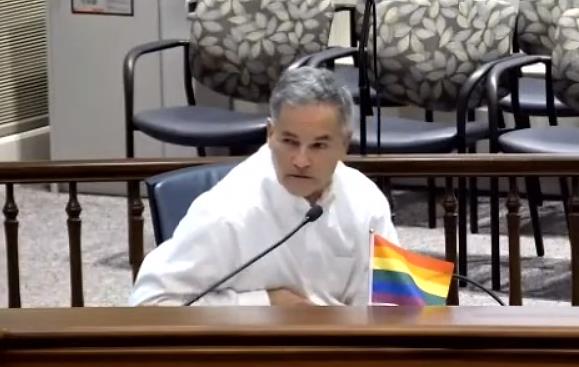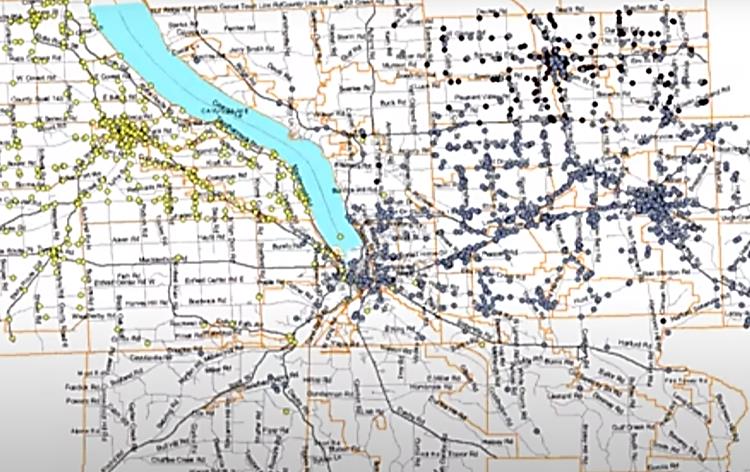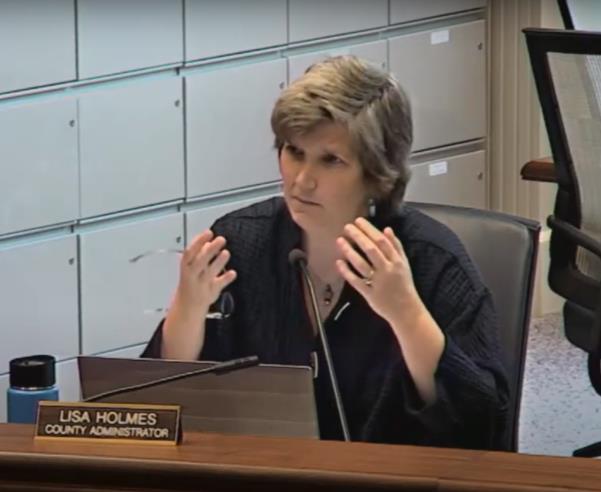Flycar municipal pay-in may hold off ‘til ‘25

by Robert Lynch, December 11, 2023
It was a discussion that this Enfield Councilperson had requested. Municipal delegates to the Tompkins County Council of Governments (TCCOG) and a handful of key County legislators conferred last Thursday, mostly online, focusing their attention on Tompkins County’s appeal for municipal financial help to pay for a new County program. It will dispatch a trio of rapid-response medical units to answer emergency calls primarily in rural communities. The discussion lasted 40 minutes. In my opinion, it went well. In terms of dollars and cents, it may have bought Enfield and our sister towns another year’s time to figure where the money will come from.
“To some extent, perhaps the ship has sailed for 2024,” Rich John, chair of the County Legislature’s Public Safety Committee, told TCCOG. John responded to my question that with Town budgets set, with municipal financing tight, and with a $232,000 County Budget contingency fund already set-aside to cover the potential local cost, isn’t it too late to ask localities this year to chip-in up to half the expense.
“If it’s going to be 20,000, 30,000, 50,000 (dollars), I don’t know where that money’s going to come from in Enfield,” I told legislator John. “And I presume other towns are going to be in the same situation.”
What’s now called the “Pilot Rapid Medical Response” (PRMR) system, a two-year experiment that Tompkins County officials hope to help launch with grant money, would establish a network of three, fast-responding, specially-equipped SUV’s, “flycars,” each staffed with an EMT, to answer medical emergencies during daytimes and only on weekdays.
The service, in the planning for more than a year and set to launch early in 2024, addresses the growing staffing shortages plaguing volunteer rescue squads in Enfield and elsewhere. Under the plan, if there’s no local responder to answer the 911 medical call, the County flycar flies to the scene.
But what never arose when municipalities first began to beg for the service a year ago has come to light now. It’s whether town governments should be asked—or cajoled; they can’t be compelled—to shoulder a portion of the operating cost, up to half of it.

Among those on the Tompkins County Legislature, Rich John, chair of the Public Safety Committee, has proven most adamant that communities like Enfield should bear a portion of the cost. He grounds his reasoning in principles of fiscal responsibility and intermunicipal equity Three of five potential funding models, unveiled in early-October, would have town governments pay half the day-to-day expense.
But at TCCOG’s meeting Thursday, Rich John’s position softened. And Enfield-Ulysses rep Anne Koreman, who’d opposed the current joint funding initiative at a mid-November meeting of John’s committee, stood in agreement with her chairman’s suggestion that local contributions be on hold for at least a year.
“I think definitely to me, 2024 is off the table,” Koreman remarked, predicting the County Legislature is “split” on municipal cost-sharing, and that it’s simply too late to bill towns given where budget cycles stand.
Rather than immediate cash, promises might suffice. The Resolution that cleared the Public Safety Committee would direct County Administrator Lisa Holmes to negotiate with individual towns—either individually or collectively—a “Memorandum of Understanding” (MOU). While John pulled the committee measure from a meeting of the full Legislature December 5th to enable TCCOG first to weigh-in, he’ll likely press for its passage later this month.
As John’s (committee-softened) Resolution now states, the proposed MOU would include agreement upon a “determination of service level commitments and the allocation of the remaining one half of the estimated 2024 operating cost of the PRMR.” The Resolution’s initial wording, phrasing favored by the Chair, would have required the agreements be struck before the flycars flew.
“The concern with the Legislature,” Rich John told TCCOG, “is precedent.” Even if no cash changes hands this year, John fears the effects of inertia: Everyone’s waiting to strike a deal will only harden positions and lull municipal leaders into assuming that PRMR is always going to be a County-paid program; “That if we just say, ‘all right, let’s start, and we’ll try to figure it out later,’ in 2025, at least one town is going to say, ‘No, it worked pretty well in 2024,’ (and so why pay anything now?)”
During autumn budget negotiations, Tompkins County lawmakers committed $232,000 of their government’s own money to underwrite at least half of the PRMR’s operational cost for next year. Another $232,000 they stuck into a contingency account. It would fund the rest of the service’s cost should municipalities—as now becomes increasingly likely—pay nothing in 2024. Should costs be shared, the contingency cash could be spent for other purposes. Legislators still need to release the funds from contingency. A request to do so could prompt a showdown before year’s end.
“Each town is approaching emergency services differently,” Dryden Councilperson Dan Lamb informed TCCOG. Lamb urged the County to take a “more nuanced approach” in any future cost-sharing negotiations. Lamb noted Dryden already contributes more than $1,000,000 a year toward its community’s own ambulance service.
Ulysses, similarly, contributes to the Trumansburg ambulance service. And Ulysses Supervisor Katelyn Olson cautioned that emergency service costs in her town are rising faster than is the tax base. Additionally, Olson questioned why that among the cost-sharing options favored by John, each of them specifically excludes Ithaca from a shared contribution. Rich John represents a City district.
“In order for me to go sell this to my community,” Olson told TCCOG, “I’m going to need to hear and explain why, frankly, the City of Ithaca doesn’t pay taxes for EMS services and the Town of Ulysses does.” Olson continued, “I’m not trying to torpedo this. I want the Town of Ulysses to be a player at the table. I want to support this initiative. But this question will need to be answered if I can go persuade Ulysses to pay in financially.”
“We should try to align the cost in some measure to the municipalities that receive the benefit, and to limit the cost to those municipalities who really aren’t seeing that much benefit from it,” John told TCCOG in defense of a cost-sharing formula that would impose its greatest burden upon the rural towns that need the new service and exclude cost-sharing for the City of Ithaca where Bangs Ambulance and Ithaca paid firefighters supposedly provide ample service. And John insisted that City residents still help subsidize the flycars, namely through the Tompkins County taxes they pay.
Yet, Trumansburg Mayor Rordan Hart infused a counterargument during Thursday’s debate. Hart shared a map of Tompkins County, a map showing which ambulance services get dispatched where. Notably, the map excludes Bangs’ calls. And it supported Hart’s claim that 25 to 30 per cent of calls to Dryden Ambulance are to addresses within the City of Ithaca, as are eight to ten per cent of calls to Trumansburg EMS.
Hart’s logic holds that rural services subsidize EMS calls provided City residents, though many people downtown may not realize it.
“A rescue-based service which will alleviate pressure from Bangs to respond rurally, which will then allow Bangs to stay home in the City of Ithaca more often, which will then allow, like dominoes, Dryden Ambulance and Trumansburg EMS to stay in our areas more often; it’s very, very important to grasp,” Hart said.

The mayor’s logic continues: That if the PRMR benefits City residents, albeit in a roundabout way, the City should be obligated to pay toward a truly-connected rescue service, Tompkins County’s flycars.
“The elephant in the room,” Hart said, “is how do we engage the City of Ithaca proper to participate in this outside of, well, every resident of the City of Ithaca will pay through county taxes.”
But persuasion could prove hard. Ithaca Alderperson Cynthia Brock, who’ll leave Common Council at year’s end, took note of the shifting of tectonic political plates in her municipality’s government. A City Manager is coming in. The City Controller has retired. Half of Common Council will be new. Flycar cost-sharing, she predicted, will have a hard time finding oxygen.
“I don’t think the City is in a position to respond as quickly to enter into either an MOU or a commitment with regard to cost-sharing at this time,” Brock cautioned.
“We want to make sure this is a collaborative effort,” Rich John told TCCOG, the Ithaca-based committee chair not so much focusing on home turf, but rather on the fertile rural funding fields that may lie beyond. “If it’s just a county program, we’re probably going to run it our way, and I’m not sure that’s optimal,” he added. “I would like this to be truly an enhancement to the overall services that are out there right now, and a cost share is a way to make sure everybody has skin in the game.”
There’s another concern that bothers the committee chair. It’s that if municipalities don’t sign on with some kind of MOU, towns may opt to cut EMS services of their own when Tompkins County rolls out the flycars. Because if that happens, he warned, “then we’re not really doing an enhancement; we’re just doing a shift.”
But achieving such a promise may prove more complicated than seen at first glimpse. As Danby Supervisor Joel Gagnon pointed quite plainly, his town and many towns—including now, Enfield—steer their EMS services through an independent Fire District, not Town Government.
And if town boards were to ratchet-back EMS services, how would they do it? How much could they save? Rescue squads go unpaid. Their vehicle is bought. Fire budgets mostly come down to things like fire trucks, fire houses, and hose; not medical supplies. And there still needs to be volunteer coverage nights and weekends.
The Tompkins County Council of Governments at its meeting took no position on cost-sharing as a principle or on whether a Memo of Understanding was a good idea. No one asked it to do so. And Danby legislator Dan Klein urged individual Town Boards not to weigh in themselves until the negotiation process proceeds a bit further. Yet still, the unease exists.

“I am concerned about what the cost share will look like in dollars and cents potentially to the smaller municipalities that don’t already have the funding or the availability… to support a service,” Mayor Hart observed. Groton legislator Lee Shurtleff warned that in time New York State may declare emergency services as essential and mandate that municipalities provide them.
But what will be required of towns like Enfield right now, in their 2024 budgets? Apparently, not the need to redirect tens of thousands of fund balance dollars to subsidize the Tompkins County flycars.
“We have the money sitting in our contingency to pay the other half, Rich John assured TCCOG’s meeting full of perhaps jittery online lawmakers. I believe it’s critical that we launch in ’24. And I would defer to Lisa (Administrator Holmes) when she comes back from negotiations and says we, the County, pays ’24, but we have commitments for ’25. That’s a fair deal in my mind.
The compromise-seeking legislative committee chair continued, “My sense is that when we get to the end of the negotiations, it may have been an ugly process, but I’m hopeful there would be some agreement that, yea, there is a cost share formula that is good enough.”
Perhaps. Just remember that the Town of Enfield will finish 2023 with a general fund balance of about $522,000. By this time next year, that figure’s predicted to tumble $60,000 lower. Tompkins County, on the other hand, is sittin’ pretty. It has a fund balance in the tens of Millions. Reaching “good enough” may take quite a reach in Town Board meeting rooms. But we’ve apparently bought some time to figure this out. TCCOG’s meeting may have borne that benefit.
###

